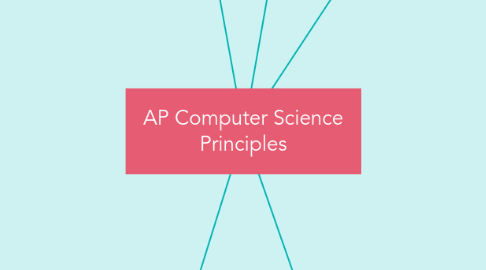
1. Unit 5 Big Data
1.1. Analyzing and Visualizing Data
1.1.1. Data Collection
1.1.2. Graphing
1.1.3. Sorting/Cleaning Data
1.2. Data Trends
1.2.1. Data and Society
1.2.2. Predicting Trends
1.2.3. Searching Algorithms
1.3. Patterns in digitally processed information.
1.4. Hypotheses to gain insight and knowledge
1.5. Collaborate when processing information
1.6. Visualisations
1.7. Computational manipulation
1.7.1. data representation
1.7.2. storage
1.7.3. security
1.7.4. transmission
1.8. Global Scalable problem solving
2. Unit 2 Programming
2.1. Define basic computer science terminology
2.1.1. hardware
2.1.2. software
2.1.3. operating system
2.1.4. programming
2.1.5. apps
2.1.6. scripts
2.1.7. algorithm
2.1.8. control structures
2.1.9. user interface
2.1.10. blocks
2.2. design procedures
2.2.1. draw,
2.2.2. make music
2.2.3. animate
2.2.4. interact with user
2.3. Loops
2.4. Algorithm
2.5. Evaluate Algorithm
2.6. Abstraction
2.7. Mathematical and Logical concepts
2.8. Develop program for creative expression
2.9. Collaborate to create a program.
3. Unit 4 - The Internet
3.1. Hardware
3.1.1. Routers
3.1.1.1. Fault Tolerance
3.1.2. Modulus Clocks
3.1.3. Network Topology
3.2. Abstractions
3.2.1. DNS
3.2.2. HTTP
3.2.3. TCP/IP
3.2.3.1. IP Addresses
3.3. Internet and Society
3.3.1. Password Protection
3.3.2. Hacking
3.3.2.1. DDOS
3.4. Characteristics of the internet
3.5. Cybersecurity concerns
3.5.1. Address concerns
3.6. Computing innovations affect communication, interaction and cognition.
4. Unit 1 Creativity and Computational Thinking
4.1. 1. Multiple Levels of Abstrations
4.2. 2. Algorithmic Expression
4.3. 3. Usability, Functionality, suitability of computational artifacts
4.4. 4. Timing in Algorithmic functions
4.5. 5. Solvable and unsolvable undecidable problems in computer science.
4.6. 6. Implementation of Algorithms by programs
4.7. 7,8. Collaboratively create computational artifact with computing tools and techniques to solve a problem
4.8. 9. Apply creative development process
5. Unit 3 - Digital Information
5.1. Number Systems
5.1.1. Binary
5.1.1.1. Binary Calculator
5.1.1.2. Logic Gates
5.1.2. Hexidecimal
5.1.2.1. RGB Values
5.1.2.2. Hexadecimal to Decimal
5.1.3. ASCII
5.1.3.1. ASCII Chart
5.1.3.2. Coversions
5.2. Abstraction
5.3. Binary sequences
5.4. Digital Models
5.5. Simulations
5.5.1. formulate
5.5.2. refine
5.5.3. test hypotheses
5.6. Computing Impact
5.6.1. benefits
5.6.2. harmful effects
5.6.3. Contexxt
5.6.3.1. economic
5.6.3.2. social
5.6.3.3. cultural

